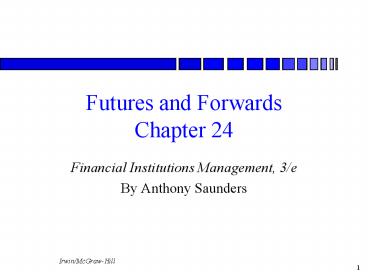Futures and Forwards Chapter 24 - PowerPoint PPT Presentation
1 / 19
Title:
Futures and Forwards Chapter 24
Description:
Spot and Forward Contracts. Spot Contract ... Forward Contract ... Credit Forwards. SF defines credit spread at time contract written ... – PowerPoint PPT presentation
Number of Views:86
Avg rating:3.0/5.0
Title: Futures and Forwards Chapter 24
1
Futures and ForwardsChapter 24
- Financial Institutions Management, 3/e
- By Anthony Saunders
2
Futures and Forwards
- Second largest group of interest rate derivatives
in terms of notional value and largest group of
FX derivatives. - Swaps are the largest.
- Rapid growth of derivatives use has been
controversial - For example, Orange County, California.
3
Spot and Forward Contracts
- Spot Contract
- Agreement at t0 for immediate delivery and
immediate payment. - Forward Contract
- Agreement to exchange an asset at a specified
future date for a price which is set at t0.
4
Futures Contracts
- Futures Contract
- Similar to a forward contract except
- Marked to market
- Exchange traded (standardized contracts)
- Lower default risk than forward contracts.
5
Hedging Interest Rate Risk
- Example 20-year 1 million face value bond.
Current price 970,000. Interest rates expected
to increase from 8 to 10 over next 3 months. - From duration model, change in bond value
- ?P/P -D ? ?R/(1R)
- ?P/ 970,000 -9 ? .02/1.08
- ?P -161,666.67
6
Example continuedNaive hedge
- Hedged by selling 3 months forward at forward
price of 970,000. - Suppose interest rate rises from 8to 10.
- 970,000 - 808,333 161,667
- (forward (spot price
- price) at t3 months)
- Exactly offsets the on-balance-sheet loss.
- Immunized.
7
Hedging with futures
- Futures used more commonly used than forwards.
- Microhedging
- Individual assets.
- Macrohedging
- Hedging entire duration gap.
- Basis risk
- Exact matching is uncommon.
8
Routine versus Selective Hedging
- Routine hedging reduces interest rate risk to
lowest possible level. - Low risk - low return.
- Selective hedging manager may selectively hedge
based on expectations of future interest rates
and risk preferences.
9
Macrohedging with Futures
- Number of futures contracts depends on interest
rate exposure and risk-return tradeoff. - DE -DA - kDL A DR/(1R)
- Suppose DA 5 years, DL 3 years and interest
rate expected to rise from 10 to 11. A 100
million. - DE -(5 - (.9)(3)) 100 (.01/1.1) -2.09
million.
10
Risk-Minimizing Futures Position
- Sensitivity of the futures contract
- DF/F -DF DR/(1R)
- Or,
- DF -DF DR/(1R) F and
- F NF PF
11
Risk-Minimizing Futures Position
- Fully hedged requires
- DF DE
- DF(NF PF) (DA - kDL) A
- Number of futures to sell
- NF (DA- kDL)A/(DF PF)
- Perfect hedge may be impossible since number of
contracts must be rounded down.
12
Basis Risk
- Spot and futures prices are not perfectly
correlated. - We assumed in our example that
- DR/(1R) DRF/(1RF)
- Basis risk remains when this condition does not
hold. Adjusting for basis risk, - NF (DA- kDL)A/(DF PF b) where
- b DRF/(1RF)/ DR/(1R)
13
Hedging FX Risk
- Hedging of FX exposure parallels hedging of
interest rate risk. - If spot and futures prices are not perfectly
correlated, then basis risk remains. - In order to adjust for basis risk, we require the
hedge ratio, - h DSt/Dft
- Nf (Long asset position h)/(size of one
contract).
14
Estimating the Hedge Ratio
- The hedge ratio may be estimated using ordinary
least squares regression - DSt a bDft Ut
- The hedge ratio, h will be equal to the
coefficient b. The R2 from the regression reveals
the effectiveness of the hedge.
15
Hedging Credit Risk
- More FIs fail due to credit-risk exposures than
to either interest-rate or FX exposures. - In recent years, development of derivatives for
hedging credit risk has accelerated. - Credit forwards, credit options and credit swaps.
16
Credit Forwards
- Credit forwards hedge against decline in credit
quality of borrower. - Common buyers are insurance companies.
- Common sellers are banks.
- Specifies a credit spread on a benchmark bond
issued by a borrower. - Example BBB bond at time of origination may have
2 spread over U.S. Treasury of same maturity.
17
Credit Forwards
- SF defines credit spread at time contract written
- ST actual credit spread at maturity of forward
- Credit Spread Credit Spread Credit Spread
- at End Seller Buyer
- STgt SF Receives Pays
- (ST - SF)MD(A) (ST - SF)MD(A)
- SFgtST Pays Receives
- (SF - ST)MD(A) (SF - ST)MD(A)
18
Futures and Catastrophe Risk
- CBOT introduced futures and options for
catastrophe insurance. - Contract volume is small but rising.
- Catastrophe futures to allow PC insurers to hedge
against extreme losses such as hurricanes. - Payoff linked to loss ratio
19
Regulatory Policy
- Require a bank to
- Establish internal guidelines regarding hedging.
- Establish trading limits.
- Disclose large contract positions that materially
affect bank risk to shareholders and outside
investors. - Beginning in 2000, derivative positions must be
marked-to-market.































